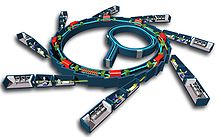SOLEIL
 SOLEIL on 10 June 2009 | |
| General properties | |
|---|---|
| Accelerator type | Synchrotron light source |
| Beam type | electrons |
| Target type | Light source |
| Beam properties | |
| Maximum energy | 2.75 GeV |
| Physical properties | |
| Circumference | 354 metres (1,161 ft) |
| Location | Saint-Aubin, France |
| Coordinates | 48°42′36″N 2°08′42″E / 48.71000°N 2.14500°E |
| Dates of operation | 2006 - present |


SOLEIL ("Sun" in French) is a synchrotron facility near Paris, France. It performed its first acceleration of electrons on May 14, 2006. The name SOLEIL is a backronym for Source optimisée de lumière d’énergie intermédiaire du LURE (LURE optimised intermediary energy light source), LURE meaning Laboratoire pour l'utilisation du rayonnement électromagnétique.
The facility is run by a civil corporation held by the French National Centre for Scientific Research (CNRS) and the French Alternative Energies and Atomic Energy Commission (CEA), two French national research agencies. It is located in Saint-Aubin in the Essonne département, a south-western suburb of Paris, near Gif-sur-Yvette and Saclay, which host other facilities for nuclear and particle physics.[citation needed]
The facility is an associate member of the University of Paris-Saclay.[citation needed]
SOLEIL also hosts IPANEMA, the European research platform on ancient materials (archaeology, palaeontology, past environments and cultural heritage), a joint CNRS / French Ministry of Culture and Communication research unit.[citation needed]
SOLEIL covers fundamental research needs in physics, chemistry, material sciences, life sciences (notably in the crystallography of biological macromolecules), earth sciences, and atmospheric sciences. It offers the use of a wide range of spectroscopic methods from infrared to X-rays, and structural methods such as X-ray diffraction and scattering.[1]
Main parameters
[edit]SOLEIL contains electrons travelling with an energy of 2.75 GeV around a 354 m circumference. It takes the electrons 1.2 μs to travel around this ring at almost the speed of light; 847,000 times per second.[2]
Most Cited Scientists at Synchrotron SOLEIL
[edit]According to Google Scholar, in 2024 this is the top 10 of most cited scientists of Synchrotron Soleil:[3]
- John Bozek
Citations: 23,755 Research Areas: X-ray physics, synchrotron radiation, XFEL, chemical physics, ultrafast X-ray
- Jose Avila
Citations: 15,273 Research Areas: Not specified
- Amina Taleb Ibrahimi
Citations: 12,628 Research Areas: Condensed matter physics, low-dimensional systems
- Timm Weitkamp
Citations: 11,773 Research Areas: X-ray imaging, microtomography, X-ray microscopy, X-ray phase contrast imaging
- Laurent Nahon
Citations: 10,754 Research Areas: Chirality, circular dichroism, molecular photoionization, VUV spectroscopy, polarimetry
Citations: 8,535 Research Areas: Physical chemistry, Material sciences, materials for energy and hydrogen
- Patrick Le Fèvre
Citations: 8,187 Research Areas: Physics
- François Bertran
Citations: 7,977 Research Areas: Physics
- Pavel Dudin
Citations: 7,775 Research Areas: Band structure, materials science, topological insulators, graphene, superconductors
- Pierre Legrand
Citations: 7,706 Research Areas: Structural virology, nucleic acid-protein interaction, crystallography, tomography, synchrotron
References
[edit]External links
[edit] Media related to Synchrotron Soleil at Wikimedia Commons
Media related to Synchrotron Soleil at Wikimedia Commons- Official website (in French)
- Official website (in English)
- LURE website (in French)
- Lightsources.org
- Official website of IPANEMA (in English)
- Official website of IPANEMA (in French)
